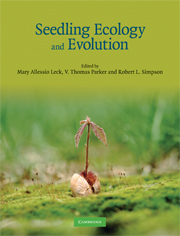Book contents
- Frontmatter
- Contents
- Contributors
- Foreword by Peter J. Grubb
- Preface
- Acknowledgments
- Part I Introduction
- Part II Seedling diversity
- Part III Seedling morphology, evolution, and physiology
- Chapter 5 Embryo morphology and seedling evolution
- Chapter 6 Regeneration ecology of early angiosperm seeds and seedlings: integrating inferences from extant basal lineages and fossils
- Chapter 7 Physiological and morphological changes during early seedling growth: roles of phytohormones
- Chapter 8 Seedling ecophysiology: strategies toward achievement of positive net carbon balance
- Chapter 9 The role of symbioses in seedling establishment and survival
- Part IV Life history implications
- Part V Applications
- Part VI Synthesis
- References
- Index
Chapter 8 - Seedling ecophysiology: strategies toward achievement of positive net carbon balance
Published online by Cambridge University Press: 05 June 2012
- Frontmatter
- Contents
- Contributors
- Foreword by Peter J. Grubb
- Preface
- Acknowledgments
- Part I Introduction
- Part II Seedling diversity
- Part III Seedling morphology, evolution, and physiology
- Chapter 5 Embryo morphology and seedling evolution
- Chapter 6 Regeneration ecology of early angiosperm seeds and seedlings: integrating inferences from extant basal lineages and fossils
- Chapter 7 Physiological and morphological changes during early seedling growth: roles of phytohormones
- Chapter 8 Seedling ecophysiology: strategies toward achievement of positive net carbon balance
- Chapter 9 The role of symbioses in seedling establishment and survival
- Part IV Life history implications
- Part V Applications
- Part VI Synthesis
- References
- Index
Summary
Introduction
Many plant ecophysiological issues, such as trade-offs associated with resource acquisition strategies, are shared between seedlings and larger plants. Yet, seedlings face several unique challenges in their struggle to achieve positive net carbon balance necessary for growth and survival. First, seedlings go through dynamic physiological changes from complete dependency on seed reserves to dependency on light and external nutrients. Second, because seedlings are small, modest changes in carbon allocation patterns will have large consequences on whole plant carbon balance and survival. Third, seedlings experience intense mortality from a wide range of abiotic and biotic factors, including strong asymmetric competition from larger neighbors, herbivory, disease, and disturbance (Moles & Westoby; 2004c; Fenner & Thompson, 2005; Kitajima, 2007; Chapter 10). Finally, phylogeny exerts a particularly strong influence on seed size (Moles et al., 2005b) and morphological traits (Saverimuttu & Westoby, 1996b; Ibarra-Manréquez et al., 2001; Zanne et al., 2005) of young seedlings. These unique aspects undoubtedly influence the evolution of resource allocation strategies in relation to the regeneration niches of species (Grubb, 1977).
In this chapter, we discuss both theoretical and technical issues important in evaluating carbon allocation strategies of seedlings. We place a large emphasis on inter- and intraspecific trade-offs due to constraints in resource allocation. Presumably, such trade-offs reflect specializations in ecological space defined by spatial and temporal heterogeneity, and ultimately restrict the range of environments in which seedlings establish (Chapters 3, 10). We explore key concepts pertaining to carbon balance strategies.
- Type
- Chapter
- Information
- Seedling Ecology and Evolution , pp. 172 - 188Publisher: Cambridge University PressPrint publication year: 2008
- 27
- Cited by



